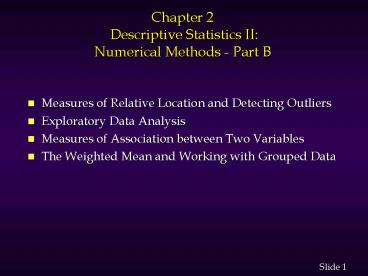Chapter 2 Descriptive Statistics II: Numerical Methods Part B - PowerPoint PPT Presentation
1 / 23
Title:
Chapter 2 Descriptive Statistics II: Numerical Methods Part B
Description:
... is an unusually small or unusually large value in a data set. ... If the data sets are samples, the covariance is ... for one-bedroom apartments presented ... – PowerPoint PPT presentation
Number of Views:55
Avg rating:3.0/5.0
Title: Chapter 2 Descriptive Statistics II: Numerical Methods Part B
1
Chapter 2 Descriptive Statistics II Numerical
Methods - Part B
- Measures of Relative Location and Detecting
Outliers - Exploratory Data Analysis
- Measures of Association between Two Variables
- The Weighted Mean and Working with Grouped Data
2
Measures of Relative Locationand Detecting
Outliers
- z-Scores
- The Empirical Rule
- Detecting Outliers
3
z-Scores
- The z-score is often called the standardized
value. - It denotes the number of standard deviations a
data value xi is from the mean. - A data value less than the sample mean will have
a z-score less than zero. - A data value greater than the sample mean will
have a z-score greater than zero. - A data value equal to the sample mean will have a
z-score of zero.
4
Example Apartment Rents
- z-Score of Smallest Value (425)
- Standardized Values for Apartment Rents
5
The Empirical Rule
- For data having a bell-shaped distribution
- Approximately 68 of the data values will be
within one standard deviation of the mean. - Approximately 95 of the data values will be
within two standard deviations of the mean. - Almost all of the items (99.7) will be
within three standard deviations of the mean.
6
Example Apartment Rents
- The Empirical Rule
- Interval in Interval
- Within /- 1s 436.06 to 545.54 48/70 69
- Within /- 2s 381.32 to 600.28 68/70 97
- Within /- 3s 326.58 to 655.02 70/70 100
7
Detecting Outliers
- An outlier is an unusually small or unusually
large value in a data set. - A data value with a z-score less than -3 or
greater than 3 might be considered an outlier. - It might be an incorrectly recorded data value.
- It might be a data value that was incorrectly
included in the data set. - It might be a correctly recorded data value that
belongs in the data set !
8
Example Apartment Rents
- Detecting Outliers
- The most extreme z-scores are -1.20 and 2.27.
- Using z gt 3 as the criterion for an outlier,
- there are no outliers in this data set.
- Standardized Values for Apartment Rents
9
Exploratory Data Analysis
- Five-Number Summary
- Smallest Value
- First Quartile
- Median
- Third Quartile
- Largest Value
10
Example Apartment Rents
- Five-Number Summary
- Lowest Value 425 First Quartile 445
- Median 475
- Third Quartile 525 Largest Value 615
11
Measures of Association between Two Variables
- Covariance
- Correlation Coefficient
12
Covariance
- The covariance is a measure of the linear
association between two variables. - Positive values indicate a positive relationship.
- Negative values indicate a negative relationship.
13
Covariance
- If the data sets are samples, the covariance is
denoted by sxy. - If the data sets are populations, the covariance
is denoted by .
14
Correlation Coefficient
- The coefficient can take on values between -1 and
1. - Values near -1 indicate a strong negative linear
relationship. - Values near 1 indicate a strong positive linear
relationship. - The formula is complex, and well use Excel to do
the mathematics for us.
15
Using Excel to Compute theCovariance and
Correlation Coefficient
- Formula Worksheet
16
Using Excel to Compute theCovariance and
Correlation Coefficient
- Value Worksheet
17
Excel, covariance and correlation
- Excel calculates a population covariance
- Excel calculates a sample correlation
- It is usually necessary to correct the covariance
to be a sample covariance (n/(n-1))
COVAR(array1,array2) n / (n-1) is the
correction factor
18
The Weighted Mean andWorking with Grouped Data
- The Weighted Mean
- Mean for Grouped Data
- Variance for Grouped Data
- Standard Deviation for Grouped Data
19
The Weighted Mean
- When the mean is computed by giving each data
value a weight that reflects its importance, it
is referred to as a weighted mean. - In the computation of a grade point average
(GPA), the weights are the number of credit hours
earned for each grade. - When data values vary in importance, the analyst
must choose the weight that best reflects the
importance of each value.
20
The Weighted Mean
- xwt ? wi xi
- ? wi
- where
- xi value of observation i
- wi weight for observation i
21
Grouped Data
- The weighted mean computation can be used to
obtain approximations of the mean, variance, and
standard deviation for grouped data. - To compute the weighted mean, we treat the
midpoint of each class as though it were the mean
of all items in the class. - We compute a weighted mean of the class midpoints
using the class frequencies as weights. - Similarly, in computing the variance and standard
deviation, the class frequencies are used as
weights.
22
Example Apartment Rents
- Given below is the previous sample of monthly
rents - for one-bedroom apartments presented here as
grouped - data in the form of a frequency distribution.
23
End of Chapter 2, Part B































